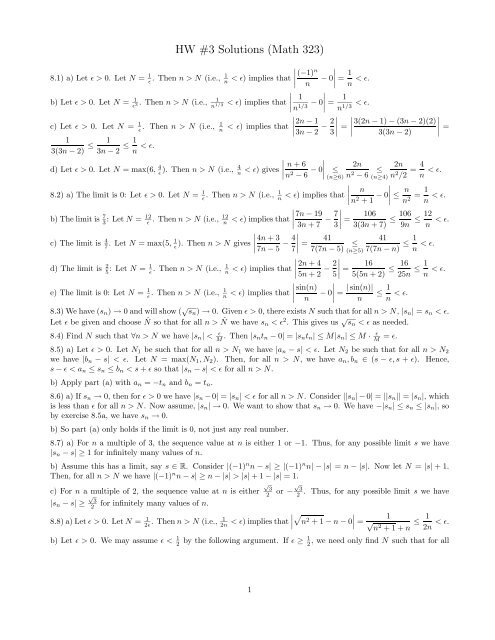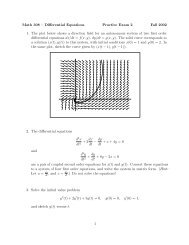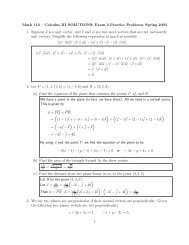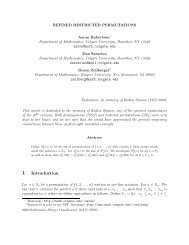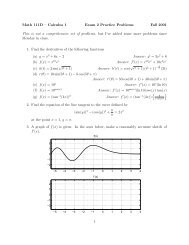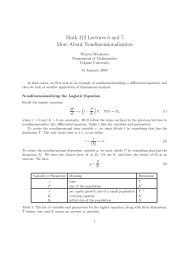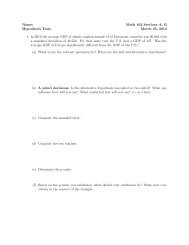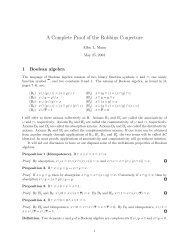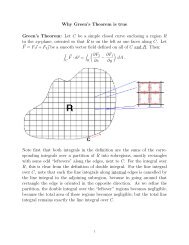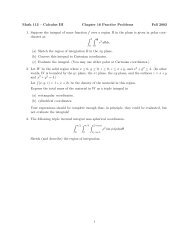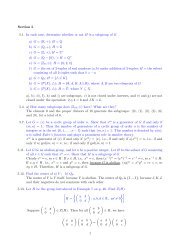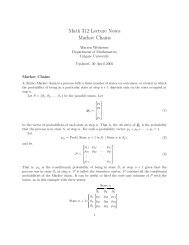HW #3 Solutions (Math 323)
HW #3 Solutions (Math 323)
HW #3 Solutions (Math 323)
- No tags were found...
Create successful ePaper yourself
Turn your PDF publications into a flip-book with our unique Google optimized e-Paper software.
<strong>HW</strong> <strong>#3</strong> <strong>Solutions</strong> (<strong>Math</strong> <strong>323</strong>)∣ ∣∣∣8.1) a) Let ɛ > 0. Let N = 1 ɛ . Then n > N (i.e., 1 n < ɛ) implies that (−1) n− 0n ∣ = 1 n < ɛ.∣ b) Let ɛ > 0. Let N = 1 1ɛ. Then n > N (i.e., < ɛ) implies that1 ∣∣∣ 3 n 1/3∣n − 0 = 1 < ɛ.1/3 n1/3 ∣c) Let ɛ > 0. Let N = 1 ɛ . Then n > N (i.e., 1∣∣∣n < ɛ) implies that 2n − 13n − 2 − 2 ∣ ∣∣∣ 3∣ = 3(2n − 1) − (3n − 2)(2)3(3n − 2) ∣ =13(3n − 2) ≤ 13n − 2 ≤ 1 n < ɛ.d) Let ɛ > 0. Let N = max(6, 4 ɛ ). Then n > N (i.e., 4 n < ɛ) gives ∣ ∣∣∣ n + 6n 2 − 6 − 0 ∣ ∣∣∣≤(n≥6)2nn 2 − 6≤(n≥4)2nn 2 /2 = 4 n < ɛ.∣ ∣ ∣∣∣8.2) a) The limit is 0: Let ɛ > 0. Let N = 1 ɛ . Then n > N (i.e., 1 n < ɛ) implies that n ∣∣∣n 2 + 1 − 0 ≤ n n 2 = 1 n < ɛ.∣b) The limit is 7 1212∣∣∣3: Let N =ɛ. Then n > N (i.e.,n < ɛ) implies that 7n − 193n + 7 − 7 3∣ = 1063(3n + 7) ≤ 1069n ≤ 12n < ɛ.∣ ∣∣∣c) The limit is 4 7 . Let N = max(5, 1 ɛ ). Then n > N gives 4n + 37n − 5 − 4 7∣ = 4141≤7(7n − 5) (n≥5) 7(7n − n) ≤ 1 n < ɛ.∣ ∣∣∣d) The limit is 2 5 : Let N = 1 ɛ . Then n > N (i.e., 1 n < ɛ) implies that 2n + 45n + 2 − 2 5∣ = 165(5n + 2) ≤ 1625n ≤ 1 n < ɛ.∣ ∣∣∣e) The limit is 0: Let N = 1 ɛ . Then n > N (i.e., 1 n < ɛ) implies that sin(n)− 0n ∣ = | sin(n)| ≤ 1 n n < ɛ.8.3) We have (s n ) → 0 and will show ( √ s n ) → 0. Given ɛ > 0, there exists N such that for all n > N, |s n | = s n < ɛ.Let ɛ be given and choose ˆN so that for all n > ˆN we have s n < ɛ 2 . This gives us √ s n < ɛ as needed.8.4) Find N such that ∀n > N we have |s n | < ɛ M . Then |s nt n − 0| = |s n t n | ≤ M|s n | ≤ M ·ɛM = ɛ.8.5) a) Let ɛ > 0. Let N 1 be such that for all n > N 1 we have |a n − s| < ɛ. Let N 2 be such that for all n > N 2we have |b n − s| < ɛ. Let N = max(N 1 , N 2 ). Then, for all n > N, we have a n , b n ∈ (s − ɛ, s + ɛ). Hence,s − ɛ < a n ≤ s n ≤ b n < s + ɛ so that |s n − s| < ɛ for all n > N.b) Apply part (a) with a n = −t n and b n = t n .8.6) a) If s n → 0, then for ɛ > 0 we have |s n − 0| = |s n | < ɛ for all n > N. Consider ||s n | − 0| = ||s n || = |s n |, whichis less than ɛ for all n > N. Now assume, |s n | → 0. We want to show that s n → 0. We have −|s n | ≤ s n ≤ |s n |, soby exercise 8.5a, we have s n → 0.b) So part (a) only holds if the limit is 0, not just any real number.8.7) a) For n a multiple of 3, the sequence value at n is either 1 or −1. Thus, for any possible limit s we have|s n − s| ≥ 1 for infinitely many values of n.b) Assume this has a limit, say s ∈ R. Consider |(−1) n n − s| ≥ |(−1) n n| − |s| = n − |s|. Now let N = |s| + 1.Then, for all n > N we have |(−1) n n − s| ≥ n − |s| > |s| + 1 − |s| = 1.c) For n a multiple of 2, the sequence value at n is either √ 32or − √ 32. Thus, for any possible limit s we have|s n − s| ≥ √ 32for infinitely many values of n.∣8.8) a) Let ɛ > 0. Let N = 1 2ɛ . Then n > N (i.e., 1∣∣2n < ɛ) implies that √ 1n2 + 1 − n − 0∣ = √n2 + 1 + n ≤ 12n < ɛ.b) Let ɛ > 0. We may assume ɛ < 1 2 by the following argument. If ɛ ≥ 1 2, we need only find N such that for all1
n > N we have ∣ √ n 2 + n − n − 1 ∣2< 1 2. We have∣∣√n2 + n − n − 1 ∣ ∣∣∣2∣ = n√n2 + n + n − 1 ∣ ∣∣∣∣2∣ = n − √ n 2 + n√ √2( √ 1 + 1/n − 1 2 − 1n 2 + n + n) ∣ = 2( √ 1 + 1/n + 1) < < 1 4 2 .( ( ) −1 ( ) 2So, let ɛ < 1 2 . Let N = 1+2ɛ1−2ɛ )2 − 1 . Then n > N implies that1n < √ (1+2ɛ1−2ɛ −1 so that 1 + 1/n 0. We may assume ɛ < 1 4 by the following argument. If ɛ ≥ 1 4, we need only find N such that for alln > N we have ∣ √ 4n 2 + n − 2n − 1 ∣4< 1 4. We have∣∣√4n2 + n − 2n − 1 ∣ ∣∣∣4∣ = n√4n2 + n + 2n − 1 ∣ ∣∣∣∣4∣ = 2n − √ 4n 2 + n√ √4( √ 1 + 1/4n − 1 2 − 14n 2 + n + 2n) ∣ = 4( √ 1 + 1/4n + 1) < < 1 4 4 .( ( ) −1 ( ) 2So, let ɛ < 1 4 . Let N = 1 1+4ɛ4 1−4ɛ )2 − 1 . Then n > N gives14n < √ ( )1+4ɛ1−4ɛ − 1 so that 1 + 1/4n N ⇒|s n − s| < ɛ = a−s2 . Hence, for all n > N we have s n < a, i.e., for all but finitely many n, s n < a, a contradiction.b) Assume, for a contradiction, that lim s n = s > b. Let ɛ = s−b2. Then, there exists N so that n > N implies|s n − s| < ɛ = s−b2 . Hence, for all n > N we have s n > b, i.e., for all but finitely many n, s n > b, a contradiction.c) This is immediate from (a) and (b).8.10) Let s n → s > a. Let ɛ = s−a2 . Then, ∃N so that n > N ⇒ |s n − s| < ɛ. By choice of ɛ, this gives us s n > a.9.1) a) We have n+1n= 1 + 1 n . Since the limit of a sum is the sum of limits, and 1 n→ 0, we are done.b) We have 3+7/n6−5/n. Use 3 + 7/n → 3, 6 − 5/n → 6, and the limit of a quotient is the quotient of the limits.c) Divide through by n 5 :17+73/n−18/n 3 +3/n 523+13/n 2 . Use numerator → 17, denominator → 23, and Theorem 9.6.9.2) a) 10 b) 18499.3) Since a n → a we have (a n ) 3 → a 3 and 4a n → 4a. Hence, since limit of a sum is the sum of limits (when thesequences are convergent) we have (a n ) 3 + 4a n → a 3 + 4a. Similarly, (b n ) 2 + 1 → b 2 + 1. Since the numerator anddenominator both converge, the limit is the quotient of the limits and we are done.9.4) a) 1, √ 2, √ √2 + 1,√ √ √2 + 1 + 1b) Let L = lim s n . Let we have lim s n+1 = lim √ s n + 1. Since we are assuming s n converges, lim √ s n + 1 =√lim(sn ) + 1 = √ L + 1. Hence, L = √ L + 1, i.e., L 2 − L − 1. Using the quadratic formula gives us 1±√ 53. Wedisregard 1−√ 52since it is negative and we clearly have a positive limit (assuming we have a limit).9.5) The justification for the following is very similar to that in Exercise 9.4b. Let t be the limit. Then t = t2 +22tso that 2t 2 = t 2 + 2, i.e., t 2 = 2. Hence, t = √ 2.9.6) Under this assumption, we would have a = 3a 2 so that a = 0 or a = 1 3 . Since x n is clearly increasing atx 1 = 1, neither limit makes sense.b) No, x n diverges to ∞.c) The method used in these last 3 problems assumes the sequence converges. This problem shows that you can usethe method and get and answer, but that answer is only justified if you have first shown that the series converges.1+2ɛ1−2ɛ).2
√9.7) Let ɛ > 0. Let N = 1 + 2 ɛ. Then n > N implies that n − 1 ≥ 2 2 ɛ, i.e.,√ 2 2nonnegative, |s n − 0| = s n 0. There exists N 1 so that n > N 1 ⇒ s n > M. Let N = max(N 0 , N 1 ). Then t n > M, ∀n > N.b) Let m < 0. There exists N 1 so that n > N 1 ⇒ t n < m. Let N = max(N 0 , N 1 ). Then s n < m for all n > N.c) Consider x n = t n − s n . For all n > N 0 we have x n ≥ 0. Since lim t n and lim s n exist, so does there difference.Clearly lim x n ≥ 0. Hence, lim(t n − s n ) = lim t n − lim s n ≥ 0 and we are done.9.10 a) We have that, given M k , there exists N so that for all n > N, s n > M k . Thus, ks n > M as needed.b) Assume lim s n = ∞ so that for any M > 0, there exists N so that n > N gives us s n > M. Hence, −s n < −M.Thus, for any m < 0, there exists N so that n > N gives us −s n < m.c) Sketch: We have s n > ∣ M ∣kso that ks n < M.9.11 a) We can’t have inf t n = ∞, so let inf t n = x ∈ R. Then t n ≥ x for all n ∈ Z + . Hence, there exists N sothat n > N ⇒ s n > M − x (since lim s n = ∞). Thus, s n + t n > M for all n > N, showing that lim(s n + t n ) = ∞.b) Let lim t n = t ∈ R. The case t = ∞ is essentially the arguement in part (a). Since t n converges, there exists Nso that n > N ⇒ t n ≥ t − 1 (using ɛ = 1 in the definition). Repeat the argument in part (a) with x = t − 1.c) If t n is bounded then there exists x ∈ R such that t n ≥ x. Repeat the argument in part (a).∣ ∣∣9.12) Use the hint. Since ∣ sn+1s nconverges, we take ɛ =a−L∣ ∣ ∣∣ ∣∣2in the definition to see that ∣∣ sn+1s n− L N.Since N is fixed, we have |s n | < ka n for some constant k > 0. Since a n → 0 we see that |s n | → 0 so that s n → 0.b) The argument is just like part (a), except we choose ɛ = L−a2and reverse all inequalities to get |s n | > ka n .Since a n diverges to ∞, by Exercise 9.10a, so must |s n |.∣ ∣ ∣ ∣∣ ∣∣9.13) a) Let |a| < 1. By Exercise 9.12a, since ∣ an+1a n=a n+1 ∣∣a = |a| < 1, we have a n → 0.nb) If |a| = 1, clearly a n → 1 since it is the constant sequence.c) If |a| > 1, by Exercise 9.12b, we have lim |a n | = ∞. In the case when a > 1, |a n | = a n so lim a n = ∞. In thecase when a < 1, we clearly have lim a 2n = ∞ while lim a 2n+1 = −∞ so that the limit doesn’t exist.∣ ∣ ∣ ∣∣ ∣∣9.14) Let |a| < 1 and let s n denote the given sequence. By Exercise 9.12a, since ∣ sn+1s n=a n+1 n p ∣∣ pa n (n+1) = |a|·(nn+1)≤p|a| < 1, we have s n → 0. If |a| = 1, we have s n = 1nwhich is easily shown (via the standard ɛ-proof) to haveplimit 0. Hence, s n → 0 for |a| ≤ 1.∣ ∣ ∣ ( ) ∣∣ ∣∣b) If a > 1, by Exercise 9.12b we have ∣ sn+1=a n+1 n p ∣∣ p ( pa n (n+1) = |a| ·np n+1 > |a| · 1a = 1 (since nn+1)→ 1 and1a < 1). Since lim ∣ ∣∣ s n+1s n∣ ∣∣ > 1 we have sn diverges to ∞.s nc) If a < −1, again lim |s n | = ∞, but we have lim s 2n = ∞ while lim s 2n+1 = −∞, so that lim s n does not exist.∣ ∣ ∣∣ ∣∣9.15) Use 9.12a. Let s n be the sequence. Then ∣ sn+1=a n+1 (n)!∣ = ∣ a∣ → 0 (for any a). Thus, s n → 0.s na n (n+1)!9.16) a) Let s n be the given sequence. Note that s n > 0 for all n. Hence, consider 1s n. We have 1n 2n 4 +8n >n2n 4 +n= 14 2n→ 0 (by Exercise 9.14 with a = 1 and p = 2). By Theorem 9.10, lim s 2 n = ∞.n+1s n= n2 +9n 4 +8n >b) We have inf{(−1) n :n ∈ Z + }=1 and by Exercise 9.14, 2nn→ ∞. Hence, by Exercise 9.11, lim ( )(−1) n + 2n2n = ∞.2c) Using Exercises 9.14 and 9.15 we have 3nn 3diverges to ∞ while − 3nn!→ 0. Let t n = − 3nn!, which is always3
negative. Since t n → 0, there exists an N such that for all n > N, |t n | < 1 (letting ɛ = 1 in the definition). Letm = min{t 1 , t 2 , . . . , t N , −1}. Then inf t n ≥ m > −∞. By Exercise 9.11, lim ( 3 nn 3 + t n)= ∞.9.17) Let M > 0. Let N = √ M. Then for all n > N, since n > √ M we have n 2 > M.9.18) a) Let S be the given sum. Note that S − aS = S(1 − a) = 1 − a n+1 . If a ≠ 1, we divide both sides by(1 − a) to obtain the resulut.b) If |a| < 1, we have a n+1 1→ 0 so the limit is1−a. c) Use your answer to (b) with a = 1/3 to get 3/2.d) If a ≥ 1, the sum is at least n. Since lim n = ∞, the given limit is ∞.10.1) Nondecreasing: c Nonincreasing: a, f Bounded: a, b, d, f10.4) The Completeness Axiom doesn’t hold over Q, so sup (inf) may not exist. Both proofs rely on this existence.10.6) a) First note that, for m > n,|s m − s n | = |s m − s m−1 + s m−1 − s m−2 + · · · + s n+1 − s n | ≤ |s m − s m−1 | + |s m−1 − s m−2 | + · · · + |s n+1 − s n |< 2 −m + 2 −m+1 + · · · + 2 −n−1= 2 −m (1 + 2 + 4 + · · · + 2 m−n+1 )−m 1−2m−n+2= 21−2= 12· (2 m−n+2 − 1) (by Ex. 9.18)m< 42 n .Now, let ɛ > 0. Let N = log 2 (4/ɛ) = 2−log 2 (ɛ). Then n > N implies that 2 n > 4 4ɛso that2< ɛ. Let m > n > N.nThen |s m − s n | < 42< ɛ and we are done (it is Cauchy and hence convergent).nb) No. Consider s n+1 = s n + 12n with s 11 = 0. We have s m = s m−1 +2(m−1) = s 1m−2 +2(m−1) + 1()2(m−2) .Continuing this we get s m = 1 21 + 1 2 + 1 3 + · · · + 1m−1. You may recognize this from calculus: for large m,s m ≈ 1 2 log(1 + m), which diverges to ∞. Since lim s m = ∞, it cannot be Cauchy (else it would be convergent).10.7) Let s = sup S. First, note that, for any given ɛ > 0, there must be infinitely many t ∈ S with t ∈ (s − ɛ, s).Otherwise, if (s − ɛ, s) contained only finitely many such t’s, say t 1 , . . . , t n , we could let m = max(t 1 , . . . , t n ) sothat t ≤ m for all s ∈ S. Since m < s, this would be a contradiction since s is the sup. We define our sequenceas follows. Choose any s 1 ∈ (s − 1, s) (taking ɛ = 1). Next, choose s 2 ∈ (s − s 1 , s). Then s 2 > s 1 . Continue bychoosing s n ∈ (s − s n−1 , s). We have constructed an increasing sequence that converges to s.10.8) We need to show that σ n+1 ≥ σ n . Substituting in, we need to show that s 1 + s 2 + · · · + s n+1 ≥ n+1n (s 1 +s 2 + · · · + s n ), i.e., we want s n+1 ≥ 1 n (s 1 + · · · + s n ). Note that s 1 ≤ s 2 ≤ · · · ≤ s n so that 1 n (s 1 + · · · + s n ) ≤1n (s n + s n + · · · + s n ) = s n . Since s n+1 ≥ s n ≥ 1 n (s 1 + · · · + s n ) we are done.10.10) a) s 2 = 2 3 ; s 3 = 5 9 ; s 4 = 1427b) s 1 = 1 > 1/2 so assume the result for n. We will show it for n + 1: s n+1 = 1 3 (s (n + 1) > 1 13 2 + 1) = 1 2 .c) We’ll show s n+1 ≤ s n , i.e., 1 3 (s n + 1) ≤ s n ⇔ 1 ≤ 2s n ⇔ s n ≥ 1 2, which was shown to be true in part (b).d) This is a nonincreasing sequence bounded from below so it converges. To find the limit, let L = lim s n . Hence,L = 1 3 (L + 1) so that L = 1 2 .10.11) a) Clearly t n+1 ≤ t n so the sequence is nonincreasing. It is bounded below by 0. This is a nonincreasingsequence bounded from below so it converges.b) Find the first few terms (1, 3/4, 45/1575/2304, 99225/147456). An (educated) guess: 2 3 .10.12) a) Clearly t n+1 ≤ t n so the sequence is nonincreasing. It is bounded below by 0. This is a nonincreasingsequence bounded from below so it converges.b) First few terms: 1, 3/4, 24/36, 360/576, 8640/14400. This one is less than 2 3 , so let’s guess 1 2 .c&d) This is true for n = 1 so let’s assume it is true for n and show for n + 1. We have t n+1 =( )( )(n+1) 2 −1 n+1(n+1) 2 2n = 1 (n+1) 2 −12(n+1) n(n+1)= 12(n+1) · n2 +2nn= n+22(n+1) → 1 2and we are done.(1 − 1(n+1) 2 )t n =4


